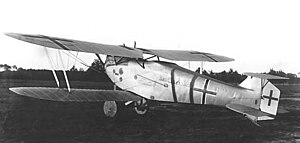| CL.II | |
|---|---|
| Role | Escort fighter |
| National origin | Germany |
| Manufacturer | Hannoversche Waggonfabrik |
| Designer | Hermann Dorner |
| First flight | 1917 |
| Primary user | Luftstreitkräfte |
| Number built | 439 |
The Hannover CL.II was an escort fighter, produced in Germany during World War I, designed in response to a 1917 requirement by the Idflieg for such a machine to protect reconnaissance aircraft over enemy territory. It was a compact biplane of largely conventional configuration with single-bay staggered wings of unequal span. The fuselage was a thin plywood paneled, wooden monocoque design, very similar to the style of fuselage in Robert Thelen's Albatros series of single-seat fighters. The main units of the fixed tailskid undercarriage were linked by a cross-axle, and the pilot and tail gunner sat in tandem, open cockpits, with the gunner's cockpit elevated above the line of the upper fuselage to afford him a greater field of fire. For the same purpose, the aircraft featured an unusually compact empennage, with a short fin and a biplane tail unit that allowed the rear gunner to have a larger field of aftwards fire when defending the aircraft. Smaller than the usual C-class reconnaissance aircraft, it was easy for enemy pilots to mistake it for a single-seat fighter; a mistake that would bring them into the line of fire of the tail gun when closing from astern.
The CL.II was also produced under licence by LFG, under the designation CL.IIa. The type was widely produced, and as the war continued, was increasingly employed as a ground attack machine, remaining in service in this role right up until the Armistice.
A copy of Hannover CL.II, named CWL SK-1 Słowik, was the first aircraft built in independent Poland, in CWL in Warsaw in 1919. It however crashed during a public flight on August 23, 1919 in Warsaw, due to faulty bracing wires, killing its constructor Karol Słowik.[1]
Specifications[]
General characteristics
- Crew: Two, pilot and gunner
- Length: 7.80 m (25 ft 7 in)
- Wingspan: 11.95 m (39 ft 3 in)
- Height: 2.75 m (9 ft 0 in)
- Wing area: 33.8 m2 (364 ft2)
- Empty weight: 750 kg (1,650 lb)
- Gross weight: 1,110 kg (2,450 lb)
- Powerplant: 1 × Argus As.III, 134 kW (180 hp)
Performance
- Maximum speed: 165 km/h (103 mph)
- Endurance: 3 hours 30 min
- Service ceiling: 7,500 m (24,600 ft)
Armament
References[]
| Wikimedia Commons has media related to Hannover CL.II. |
- ↑ Morgała, Andrzej. O samolocie inż. Słowika raz jeszcze in: "Lotnictwo z szachownicą" nr. 21(1/2007), pp.30-33 (Polish)
- Taylor, Michael J. H. (1989). Jane's Encyclopedia of Aviation. London: Studio Editions. pp. 468.
- World Aircraft Information Files. London: Bright Star Publishing. pp. File 986 Sheet 09.
The original article can be found at Hannover CL.II and the edit history here.
